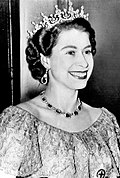Queen of Tanganyika
| Queen of Tanganyika | |
|---|---|

|
|

Elizabeth II, 1953
|
|
| Details | |
| Style | Her Majesty |
| Formation | 9 December 1961 |
| Abolition | 9 December 1962 |
From 1961 to 1962, Tanganyika was an independent sovereign state with Elizabeth II as its queen. The Queen was formal head of state and was represented in Tanganyika by the Governor-General. Tanganyika shared the Sovereign with the other Commonwealth realms, including the United Kingdom.
The monarchy was created by the Tanganyika Independence Act 1961 which transformed the United Nations trust territory of Tanganyika into an independent sovereign constitutional monarchy. The monarchy was abolished in 1962, when Tanganyika became a republic within the Commonwealth with the President of Tanganyika as head of state. The Round Table: The Commonwealth Journal of International Affairs wrote:
On December 9, 1961, when Tanganyika became independent, it suddenly became a monarchy with the monarch as Queen of Tanganyika. But the British monarchy was regarded as a foreign institution and the new position increased the sense of alienation from the Crown. It is made clear, however, that the proposal to become a republic does not imply any disrespect towards the person of the Queen, whose position as Head of the Commonwealth is readily acknowledged ... The chief, as the leader of the tribe, still holds a position of great importance in most areas ... by and large the chiefs have retained the affection and loyalty of their people and since it is a monarchical system, it might be thought that the idea of monarchy was acceptable to the people and that in some areas it was strongly entrenched. There is, however, a difference between the monarchical idea of chieftainship and that of an alien monarch who is a European and who lives thousands of miles away and is never seen. The days have gone when the English sovereign can be expected to command the personal loyalty of African subjects in the same way as people of British origin.
...
Wikipedia
